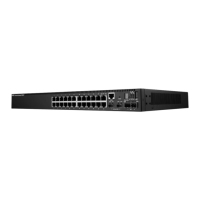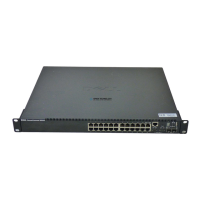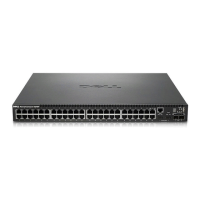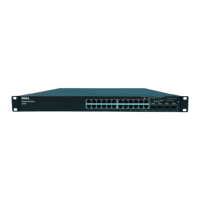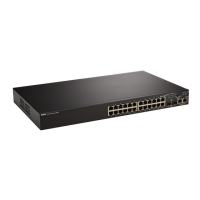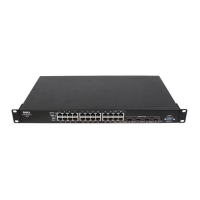
Do you have a question about the Dell PowerConnect 5324 and is the answer not in the manual?
| Switching Capacity | 48 Gbps |
|---|---|
| VLAN Support | Yes |
| Rack Mountable | Yes |
| Device Type | Switch |
| MAC Address Table Size | 8K entries |
| RAM | 64 MB |
| Flash Memory | 8 MB |
| Power Device | Internal power supply |
| Voltage Required | AC 120/230 V (50/60 Hz) |
| Jumbo Frame Support | Yes |
| Ports | 24 x 10/100/1000 + 2 x SFP |
| Management | Web-based, SNMP, CLI |
| Enclosure Type | Rack-mountable |
| Routing Protocol | Static IP routing |
| Remote Management Protocol | SNMP 1, 2, 3 |
| Features | Flow control, auto-negotiation, port mirroring, Quality of Service (QoS) |
| Compliant Standards | IEEE 802.3, IEEE 802.3u, IEEE 802.3ab, IEEE 802.3x |
| Operating Temperature | 0 °C to 45 °C |
| Storage Temperature | -20 °C to 70 °C |
| Humidity | 5% to 95% (non-condensing) |
| Layer | Layer 2 |
Introduces the PowerConnect 5324, its ports, and physical layout.
Overview of user-configurable features of the device.
Describes features like HOL blocking, VCT, Jumbo Frames, MDI/MDIX, Flow Control, Back Pressure.
Covers MAC address capacity, learning, aging, static entries, and VLAN-aware switching.
Discusses Port Mirroring, Broadcast Storm Control, and VLAN support.
Details VLAN support, Port-Based VLANs, IEEE 802.1V, and 802.1Q tagging.
Explains STP, Fast Link, IEEE 802.1w RSTP, and Link Aggregation.
Covers ARP, TCP, and BootP/DHCP clients.
Explains 802.1p support and Class of Service.
Details SNMP, Web-based management, TFTP, Remote Monitoring, and CLI.
Describes front and back panel port configurations.
Explains the function of front panel LEDs for status indication.
Describes internal components like power supplies and ventilation.
Safety instructions and precautions before performing installation procedures.
Conditions for rack or tabletop installation, power, clearance, and environment.
Details package contents and the process of unpacking the device.
Procedures for installing the device in a rack or on a flat surface.
How to connect the device to a terminal for configuration.
Default configurations for port speed, duplex, and flow control.
Basic setup steps for a new device, including username, IP, and SNMP.
Configuring static IP, subnet mask, and default gateway.
Configuring user names and privilege levels for remote access.
Method for managing network devices using SNMP, community strings, and access rights.
Dynamic IP allocation and security management using AAA mechanisms.
Steps for the device to obtain an IP address from a DHCP server.
System security handled via AAA, local/remote databases, and SSH encryption.
Setting up security passwords for Terminal, Telnet, SSH, HTTP, and HTTPS.
Overview of procedures accessible from the Startup menu.
Explains the components of the Switch Administrator interface, like Tree View and Device View.
Steps to launch and access the Dell PowerConnect Switch Administrator.
How to manage the device via console or Telnet connection.
How to configure general system details like name, contact, and location.
How to set up Simple Network Time Protocol for clock synchronization.
Information on configuring and managing system logs.
Covers default gateways, IP interfaces, and DHCP/DNS configurations.
How to set up DNS servers and default domains.
Managing Address Resolution Protocol entries.
Performing tests on copper and fiber optic cables.
Details on network security features like port-based authentication and port security.
Setting up IEEE 802.1x authentication for ports using RADIUS and EAP.
Settings for port parameters, LAGs, storm control, and port mirroring.
Managing static and dynamic MAC address tables.
How to configure GARP VLAN Registration Protocol for VLAN distribution.
Explains STP, Fast Link, IEEE 802.1w RSTP, and Link Aggregation.
Information on creating and managing VLANs.
Details on Link Aggregation, LAGs, and LACP.
How multicast forwarding works and the device's support for it.
Enabling and configuring IGMP snooping for multicast traffic.
Links to display statistics in chart form, including utilization summary.
Statistics for received and transmitted packets per interface.
Interface statistics related to Etherlike protocols.
Device statistics for GVRP protocol.
Network information for device utilization and errors via RMON.
Links to display statistics in a chart form.
Introduction to QoS, its definition, and benefits in network traffic management.
Setting global Class of Service parameters for traffic classification.
Configuring QoS settings on a per-interface basis.
Configuring scheduling methods for traffic queues.
Mapping Class of Service values to specific forwarding queues.
Mapping DSCP values to forwarding queues for QoS.
Details on port types (RJ-45, SFP) and cable requirements.
Information on temperature, humidity, and ventilation.
Details on unit size and ventilation.
Information on CPU DRAM, Flash Memory, and Packet Buffer.
Summary of key features like VLAN, QoS, security, and aggregation.
